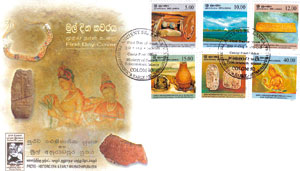Proto-Historic and
Early Anuradhapura Eras
It has been revealed that inhabitants of Sri Lanka around 1000 B.C., used iron implements, did agriculture using knowledge on irrigation and manufactured clay
utensils – all evidence of a
developed cultural heritage. Until the Anuradhapura Era there was a transitional period identified as the Proto-Historic Age.
The only evidence available during this era is around
30 burial sites and some clay utensils used at the time. These have been unearthed at Ibbankatuwa, Yatigalpotta, Pomparippuwa and a site called Galsohon kanatta. The burial sites have been classified as pit burials, cist burials, urn burials and dolman.
The black and reddish clay
utensils of that era are considered as high technique creations. Remains of a cist burial and a necklace of beads found at Ibbankatuwa are featured in the Rs. 5 stamp – the first in a series of six issued on April 30, 2008.
Anuradhapura began to emerge as a city around 900 B.C. For at least three centuries there had been
habitats covering an area of about
50 hectares. The area situated around Malwatu Oya was abundant with mineral resources, water and fertile soil and was protected by a thick
forest cover thereby shielding it from any possible invasions. The name ‘Anuradhapura’ or ‘City of Anuradha’ had derived from the original
habitat founded by Prince Anuradha, a provincial chieftain who came with Prince Vijaya. An inscription written on a clay slab in Brahmi script found by Professor Shiran Deraniyagala mentions Anuradhapura.
The
inscription dates back to 6th – 5th
centuries B.C.It was King Pandukabhaya who created a planned city after he came to the throne in 4th century B.C. The Abhayawewa – better known as Basawakkulama – shown in the
Rs. 10 stamp (with Ruwanveliseya in the background) dates back to the
3rd century B.C. and is accepted as the first giant tank constructed in the capital. King Devanapiyatissa built the Tissawewa. With irrigation,
agriculture thrived in the Anuradhapura era and a
self-sufficient nation emerged.
The art of letters gradually
developed and the Brahmi
alphabet evolved. The Vallipuram gold plate (Rs. 12 stamp) had been found at the Vishnu kovil premises at the Vallipuram village in the Vadamarachchi Division in the
Jaffna Peninsula.
The small gold leaf
3 ½ inches long and one inch wide
contains a four-line letter written in Brahmi script. It belongs to the reign of King Vasabha (65 – 109 AD). The letter states that “in the reign of Vasabha, his minister Isigirya
administering Nagadipa built a vihara bearing the name Piyangukatissa at a place called Bandakaraatana.”
The use of iron progressively increased from the pre-historic times. In the Anuradhapura Era, Sri Lanka gained a name for its high standards of iron and steel products. Melting furnaces were found everywhere
and the early settlers possessed
technical know-how to process not only iron but also other metals such as copper, silver, gold and bronze.
The Rs. 15 stamp features an iron
furnace located at Alakolawwewa area close to Sigiriya traced back to 1st – 2nd centuries A.D.
The use of money was begun around the 3rd century B.C.
replacing the barter system when people exchanged goods and products. The earliest coins made of copper and silver were known as ‘purana’ and were circular, oval, rectangular and triangular in shape. Symbols like the sun, trees, animals, human beings, fish and mountain ranges were engraved on them.
The Gaja Lakshmi coin – a unique creation in copper – seen in the
Rs. 30 stamp (left) bears the portrait of Goddess Lakshmi on the obverse and the ‘swastika’ on its reverse.
On the right is a ‘swastika’ coin
2 – 2.5 centimetres in size and nearly 250 grains in weight.
While there is evidence of the existence of the art of painting in the pre-historic age, it was after the introduction of Buddhism that the art developed. When the Sri Maha Bodhi was brought to Sri Lanka, Indian craftsmen had arrived and settled down.
Paintings had been found in a number of places including Situlpauwa, Sigiriya, Vessagiriya, Mihintale relic chamber, Hindagala, Pulligoda, Gonagolla and the western gate of Ruvanveliseya. Jataka stories had been painted in the inner walls of Ruvanveliseya.
A Sigiriya fresco belonging to the 5th century A.D., is seen in the Rs. 40 stamp. |


